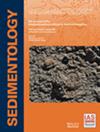Testing magnetic tracers as indicators of sediment transport in a wave flume experiment
IF 2.6
2区 地球科学
Q1 GEOLOGY
引用次数: 1
Abstract
The in situ measurement of sediment transport in wave‐dominated environments presents significant challenges and currently often relies upon the use of fluorescent sediment tracers. However, this method is constrained by challenges in conducting unbiased and representative sampling, as well as facing overall logistical complexities and labour‐intensive procedures. Whilst other tracer techniques are available, such as using magnetic tracers, their performance in tracking sediment transport has not been quantified. The objective of this study is to assess the effectiveness of magnetic tracers in evaluating net transport rates and tracer dispersal patterns. Conducted in a controlled large wave flume, the experiments simultaneously employed fluorescent and magnetic tracers, allowing a comprehensive comparison of the tracers' dispersion patterns and the net transport rates. Results show that the dispersal of magnetic and fluorescent tracers displays a high degree of spatial coherence in both horizontal and vertical dimensions. Similarly, net transport rates are comparable (<16% difference), both showing net transport in the direction of the wave propagation (towards onshore) driven by non‐linear and streaming effects. Magnetic tracer recovery rate (49%) was lower than for fluorescent tracers (73%) and is attributed to the loss of magnetic ink from particles; an aspect of the magnetic technique that requires improvement. This study therefore indicates that the use of magnetic tracers to quantify sediment transport is an effective method with the advantages of being significantly less labour‐intensive than using the commonly applied fluorescent sediment tracer method.在波浪水槽实验中测试磁追踪器作为沉积物迁移指标的作用
在波浪为主的环境中对沉积物迁移进行现场测量是一项重大挑战,目前通常依赖于使用荧光沉积物示踪剂。然而,这种方法在进行无偏见、有代表性的取样方面存在挑战,而且面临整体后勤复杂性和劳动密集型程序的制约。虽然还有其他示踪技术,如使用磁性示踪剂,但它们在跟踪沉积物迁移方面的性能尚未得到量化。本研究旨在评估磁性示踪剂在评价净迁移率和示踪剂扩散模式方面的有效性。实验在受控的大浪水槽中进行,同时使用荧光和磁性示踪剂,以便全面比较示踪剂的扩散模式和净迁移率。结果表明,磁性示踪剂和荧光示踪剂的扩散在水平和垂直维度上都表现出高度的空间一致性。同样,两者的净迁移率也相当(相差小于 16%),都显示出在非线性效应和流效应的驱动下,向波浪传播方向(岸上)的净迁移。磁性示踪剂的回收率(49%)低于荧光示踪剂的回收率(73%),原因是磁性墨水从颗粒上流失;这是磁性技术需要改进的一个方面。因此,这项研究表明,使用磁性示踪剂来量化沉积物迁移是一种有效的方法,其优点是与常用的荧光沉积物示踪法相比,大大降低了劳动强度。
本文章由计算机程序翻译,如有差异,请以英文原文为准。
求助全文
约1分钟内获得全文
求助全文
来源期刊

Sedimentology
地学-地质学
CiteScore
8.20
自引率
11.40%
发文量
94
审稿时长
6-12 weeks
期刊介绍:
The international leader in its field, Sedimentology publishes ground-breaking research from across the spectrum of sedimentology, sedimentary geology and sedimentary geochemistry.
Areas covered include: experimental and theoretical grain transport; sediment fluxes; modern and ancient sedimentary environments; sequence stratigraphy sediment-organism interaction; palaeosoils; diagenesis; stable isotope geochemistry; environmental sedimentology
 求助内容:
求助内容: 应助结果提醒方式:
应助结果提醒方式:


